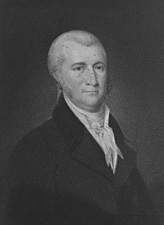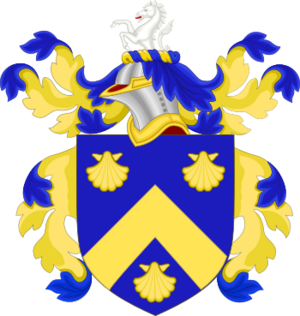James A. Bayard (politician, born 1767) facts for kids
Quick facts for kids
James Asheton Bayard Sr.
|
|
|---|---|
 |
|
| United States Senator from Delaware |
|
| In office November 13, 1804 – March 3, 1813 |
|
| Preceded by | William H. Wells |
| Succeeded by | William H. Wells |
| Member of the U.S. House of Representatives from Delaware's At-large district |
|
| In office March 4, 1797 – March 3, 1803 |
|
| Preceded by | John Patten |
| Succeeded by | Caesar A. Rodney |
| Personal details | |
| Born |
James Asheton Bayard
July 28, 1767 Philadelphia, Pennsylvania |
| Died | August 6, 1815 (aged 48) Wilmington, Delaware |
| Political party | Federalist |
| Spouse | Ann (Nancy) Bassett |
| Children | 6, including Richard and James |
| Parents | James Asheton Bayard Ann Hodge |
| Residences | Wilmington, Delaware |
| Alma mater | Princeton University |
| Profession | Lawyer |
| Signature | |
James Asheton Bayard Sr. (born July 28, 1767 – died August 6, 1815) was an important American lawyer and politician. He was from Wilmington, Delaware. Bayard was a member of the Federalist Party. He served as a U.S. Representative and later as a U.S. Senator for Delaware.
Contents
Early Life and Education
James Asheton Bayard was born in Philadelphia, Pennsylvania. His parents were Dr. James Asheton Bayard and Ann Hodge. The Bayard family had a long history in America. They were related to Peter Stuyvesant, an early Dutch leader.
When James's parents died young, he went to live with his uncle, Colonel John Bubenheim Bayard. James studied at Princeton College and graduated in 1784. He then studied law and became a lawyer in 1787. He started his law practice in Wilmington, Delaware.
In 1795, Bayard married Ann Bassett. She was the daughter of Richard Bassett, a wealthy lawyer and U.S. Senator. James and Ann had six children. Their sons, Richard and James Jr., also became U.S. Senators.
Serving in the U.S. House of Representatives
Bayard was first elected to the United States House of Representatives in 1796. He served three terms, from 1797 to 1803. In the House, he was known for his strong speeches and his knowledge of the U.S. Constitution. He became a key leader for the Federalist Party.
One important event was his role in the impeachment of Senator William Blount in 1798. Impeachment is when a government official is accused of wrongdoing. Bayard helped lead the effort to remove Blount from office. Blount was accused of trying to help the British against the Spanish. The House voted to impeach him. However, the Senate decided they could not take further action once he was dismissed. This set an important rule for how Congress handles its members.
Bayard also played a big part in the presidential election of 1800. The election was tied in the Electoral College. This meant the House of Representatives had to choose the next president. Bayard led a group of Federalists who helped break the tie. They allowed Thomas Jefferson to be elected president. It is believed Bayard made a deal with Jefferson. This deal allowed some Federalists to keep their government jobs.
In 1801, President John Adams offered Bayard a job as Minister to France. But Bayard turned down the offer.
Bayard was very good at disagreeing with Jefferson's government. Because of this, the opposing party, the Democratic-Republicans, tried hard to defeat him in 1802. Caesar Augustus Rodney defeated Bayard by a small number of votes. However, Bayard won against Rodney two years later in 1804. Even though they were political rivals, they remained friends.
Serving in the U.S. Senate and Peace Efforts
Even though Bayard won re-election to the U.S. House in 1804, he did not return there. Instead, he was chosen by the Delaware General Assembly to be a U.S. Senator. He filled a vacant seat in November 1804. He then started his own full term in March 1805. He was re-elected in 1810 and served in the Senate until 1813.
Bayard and most Federalists did not want the War of 1812. They called it "Mr. Madison's War." But they were also upset by British actions at sea. Bayard worried about how unprepared the U.S. army and navy were. He especially worried about Delaware's coast. On June 17, 1812, he voted against declaring war on Britain. However, once the war started, he and other Delaware Federalists fully supported the war effort.
Because of his support, Bayard was the only Federalist chosen to be a peace commissioner. These commissioners negotiated the Treaty of Ghent. This treaty officially ended the War of 1812 in December 1814. Bayard resigned from the Senate to go to Europe for these talks. He played a very important role in the negotiations. John Quincy Adams, who led the American team, praised Bayard. He said Bayard was very calm and controlled his feelings well.
After the war, President James Madison offered Bayard a job as Minister to Russia. But Bayard declined again. He felt a Federalist could not properly represent a Democratic-Republican government.
Death and Legacy
After several months in Europe, Bayard returned home in the summer of 1815. During his trip, he became very ill with a throat infection. He died in Wilmington just five days after returning home.
Bayard was first buried in Maryland. Later, in 1842, his remains were moved to the Wilmington and Brandywine Cemetery in Wilmington. His father-in-law, Richard Bassett, was also reburied there.
James Asheton Bayard Sr. left a lasting legacy. He was the father of two U.S. Senators, Richard H. Bayard and James A. Bayard Jr.. He was also the grandfather of another Senator, Thomas F. Bayard Sr., and the great-grandfather of yet another, Thomas F. Bayard Jr.. This shows his family's strong connection to public service.
He was sometimes called The Chevalier, the Goliath of his Party, and High Priest of the Constitution. These nicknames show how important and respected he was in his time.
Images for kids


